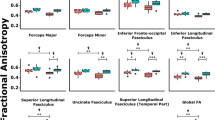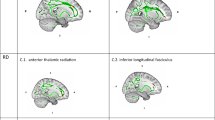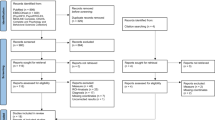Abstract
Diffusion tensor imaging (DTI) has been used to evaluate white matter (WM) integrity in major depressive disorder (MDD), with several studies reporting differences between depressed patients and controls. However, these findings are variable and taken from relatively small studies often using suboptimal analytic approaches. The presented DTI study examined WM integrity in large samples of medication-free MDD patients (n=134) and healthy controls (n=54) using voxel-based morphometry (VBM) and tract-based spatial statistics (TBSS) approaches, and rigorous statistical thresholds. Compared with health control subjects, MDD patients show no significant differences in fractional anisotropy, radial diffusivity, mean diffusivity, and axonal diffusivity with either the VBM or the TBSS approach. Our findings suggest that disrupted WM integrity does not have a major role in the neurobiology of MDD in this relatively large study using optimal imaging acquisition and analysis; however, this does not eliminate the possibility that certain patient subgroups show WM disruption associated with depression.
Similar content being viewed by others
Log in or create a free account to read this content
Gain free access to this article, as well as selected content from this journal and more on nature.com
or
References
Abe O, Takao H, Gonoi W, Sasaki H, Murakami M, Kabasawa H et al (2010). Voxel-based analysis of the diffusion tensor. Neuroradiology 52: 699–710.
Andersson JL, Skare S, Ashburner J (2003). How to correct susceptibility distortions in spin-echo echo-planar images: application to diffusion tensor imaging. NeuroImage 20: 870–888.
Ashburner J, Friston KJ (2000). Voxel-based morphometry—the methods. NeuroImage 11 (6 Pt 1): 805–821.
Bae JN, MacFall JR, Krishnan KR, Payne ME, Steffens DC, Taylor WD (2006). Dorsolateral prefrontal cortex and anterior cingulate cortex white matter alterations in late-life depression. Biol Psychiatry 60: 1356–1363.
Behrens TE, Woolrich MW, Jenkinson M, Johansen-Berg H, Nunes RG, Clare S et al (2003). Characterization and propagation of uncertainty in diffusion-weighted MR imaging. Magn Reson Med 50: 1077–1088.
Blood AJ, Iosifescu DV, Makris N, Perlis RH, Kennedy DN, Dougherty DD et al (2010). Microstructural abnormalities in subcortical reward circuitry of subjects with major depressive disorder. PLoS one 5: e13945.
Bullmore ET, Suckling J, Overmeyer S, Rabe-Hesketh S, Taylor E, Brammer MJ (1999). Global, voxel, and cluster tests, by theory and permutation, for a difference between two groups of structural MR images of the brain. IEEE Trans Med Imaging 18: 32–42.
Cole J, Chaddock CA, Farmer AE, Aitchison KJ, Simmons A, McGuffin P et al (2012). White matter abnormalities and illness severity in major depressive disorder. Br J Psychiat 201: 33–39.
Craddock RC, Holtzheimer PE 3rd, Hu XP, Mayberg HS (2009). Disease state prediction from resting state functional connectivity. Magn Resonance Med 62: 1619–1628.
Craddock RC, James GA, Holtzheimer PE III, Hu XP, Mayberg HS (2012). A whole brain fMRI atlas generated via spatially constrained spectral clustering. Hum Brain Mapp 33: 1914–1928.
Cullen KR, Klimes-Dougan B, Muetzel R, Mueller BA, Camchong J, Houri A et al (2010). Altered white matter microstructure in adolescents with major depression: a preliminary study. J Am Acad Child Adolesc Psychiatry 49: 173–183 e171.
Drevets WC, Price JL, Furey ML (2008a). Brain structural and functional abnormalities in mood disorders: implications for neurocircuitry models of depression. Brain Struct Funct 213: 93–118.
Drevets WC, Savitz J, Trimble M (2008b). The subgenual anterior cingulate cortex in mood disorders. CNS Spectr 13: 663–681.
Dunlop BW, Binder EB, Cubells JF, Goodman MG, Kelley ME, Kinkead B et al (2012a). Predictors of Remission in Depression to Individual and Combined Treatments (PReDICT): study protocol for a randomized controlled trial. Trials 13: 106.
Dunlop BW, Kelley ME, Mletzko TC, Velasquez CM, Craighead WE, Mayberg HS (2012b). Depression beliefs, treatment preference, and outcomes in a randomized trial for major depressive disorder. J Psychiatr Res 46: 375–381.
First MB SR, Gibbon M, Williams JBW (1995) Structured Clinical Interview for DSM-IV Axis I Disorders-Patient Edition (SCID-I/P, Version 2.0). Biometrics Research Department, New York State Psychiatric Institute: New York.
Good CD, Johnsrude IS, Ashburner J, Henson RN, Friston KJ, Frackowiak RS (2001). A voxel-based morphometric study of ageing in 465 normal adult human brains. NeuroImage 14 (1 Pt 1): 21–36.
Greicius M (2008). Resting-state functional connectivity in neuropsychiatric disorders. Curr Opin Neurol 21: 424–430.
Greicius MD, Flores BH, Menon V, Glover GH, Solvason HB, Kenna H et al (2007). Resting-state functional connectivity in major depression: abnormally increased contributions from subgenual cingulate cortex and thalamus. Biol Psychiatry 62: 429–437.
Griswold MA, Jakob PM, Heidemann RM, Nittka M, Jellus V, Wang J et al (2002). Generalized autocalibrating partially parallel acquisitions (GRAPPA). MagnReson Med 47: 1202–1210.
Hafeman DM, Chang KD, Garrett AS, Sanders EM, Phillips ML (2012). Effects of medication on neuroimaging findings in bipolar disorder: an updated review. Bipolar Disord 14: 375–410.
Hagmann P, Cammoun L, Gigandet X, Meuli R, Honey CJ, Wedeen VJ et al (2008). Mapping the structural core of human cerebral cortex. PLoS Biol 6: e159.
Harrison PJ (2002). The neuropathology of primary mood disorder. Brain 125 (Pt 7): 1428–1449.
Huang H, Ceritoglu C, Li X, Qiu A, Miller MI, van Zijl PC et al (2008). Correction of B0 susceptibility induced distortion in diffusion-weighted images using large-deformation diffeomorphic metric mapping. Mag Reson Imaging 26: 1294–1302.
James GA, Kelley ME, Craddock RC, Holtzheimer PE, Dunlop BW, Nemeroff CB et al (2009). Exploratory structural equation modeling of resting-state fMRI: applicability of group models to individual subjects. NeuroImage 45: 778–787.
Jenkinson M, Bannister P, Brady M, Smith S (2002). Improved optimization for the robust and accurate linear registration and motion correction of brain images. NeuroImage 17: 825–841.
Kieseppa T, Eerola M, Mantyla R, Neuvonen T, Poutanen VP, Luoma K et al (2010). Major depressive disorder and white matter abnormalities: a diffusion tensor imaging study with tract-based spatial statistics. J Affect Disord 120: 240–244.
Korgaonkar MS, Grieve SM, Koslow SH, Gabrieli JD, Gordon E, Williams LM (2011). Loss of white matter integrity in major depressive disorder: evidence using tract-based spatial statistical analysis of diffusion tensor imaging. Hum Brain Mapp 32: 2161–2171.
Le Bihan D, Mangin JF, Poupon C, Clark CA, Pappata S, Molko N et al (2001). Diffusion tensor imaging: concepts and applications. J Magn ResonImaging 13: 534–546.
Li L, Coles CD, Lynch ME, Hu X (2009). Voxelwise and skeleton-based region of interest analysis of fetal alcohol syndrome and fetal alcohol spectrum disorders in young adults. Hum Brain Mapp 30: 3265–3274.
Ma N, Li L, Shu N, Liu J, Gong G, He Z et al (2007). White matter abnormalities in first-episode, treatment-naive young adults with major depressive disorder. Am J Psychiatry 164: 823–826.
Mayberg HS (2003a). Modulating dysfunctional limbic-cortical circuits in depression: towards development of brain-based algorithms for diagnosis and optimised treatment. Br Med Bull 65: 193–207.
Mayberg HS (2003b). Positron emission tomography imaging in depression: a neural systems perspective. Neuroimaging ClinN Am 13: 805–815.
Mayberg HS (2009). Targeted electrode-based modulation of neural circuits for depression. J Clin Invest 119: 717–725.
McGrath CL, Kelley ME, Holtzheimer PE, Dunlop BW, Craighead WE, Franco AR et al (2013). Toward a neuroimaging treatment selection biomarker for major depressive disorder. JAMA Psychiatry 70: 821–829.
McKenna MT, Michaud CM, Murray CJ, Marks JS (2005). Assessing the burden of disease in the United States using disability-adjusted life years. Am J Preventive Med 28: 415–423.
Murray EA, Wise SP, Drevets WC (2011). Localization of dysfunction in major depressive disorder: prefrontal cortex and amygdala. Biol Psychiatry 69: e43–e54.
Ongur D, Heckers S (2004). A role for glia in the action of electroconvulsive therapy. Harvard Rev Psychiatry 12: 253–262.
Oouchi H, Yamada K, Sakai K, Kizu O, Kubota T, Ito H et al (2007). Diffusion anisotropy measurement of brain white matter is affected by voxel size: underestimation occurs in areas with crossing fibers. AJNR Am J Neuroradiol 28: 1102–1106.
Phillips ML (2006). The neural basis of mood dysregulation in bipolar disorder. Cogn Neuropsychiatry 11: 233–249.
Pierpaoli C, Basser PJ (1996). Toward a quantitative assessment of diffusion anisotropy. Magn Reson Med 36: 893–906.
Rajkowska G (2003). Depression: what we can learn from postmortem studies. Neuroscientist 9: 273–284.
Seminowicz DA, Mayberg HS, McIntosh AR, Goldapple K, Kennedy S, Segal Z et al (2004). Limbic-frontal circuitry in major depression: a path modeling metanalysis. NeuroImage 22: 409–418.
Sheline YI, Price JL, Yan Z, Mintun MA (2010). Resting-state functional MRI in depression unmasks increased connectivity between networks via the dorsal nexus. Proc Natl Acad Sci USA 107: 11020–11025.
Smith SM, Jenkinson M, Johansen-Berg H, Rueckert D, Nichols TE, Mackay CE et al (2006). Tract-based spatial statistics: voxelwise analysis of multi-subject diffusion data. NeuroImage 31: 1487–1505.
Smith SM, Jenkinson M, Woolrich MW, Beckmann CF, Behrens TE, Johansen-Berg H et al (2004). Advances in functional and structural MR image analysis and implementation as FSL. NeuroImage 23 (Suppl 1): S208–S219.
Smith SM, Johansen-Berg H, Jenkinson M, Rueckert D, Nichols TE, Miller KL et al (2007). Acquisition and voxelwise analysis of multi-subject diffusion data with tract-based spatial statistics. Nature protocols 2: 499–503.
Song SK, Sun SW, Ramsbottom MJ, Chang C, Russell J, Cross AH (2002). Dysmyelination revealed through MRI as increased radial (but unchanged axial) diffusion of water. NeuroImage 17: 1429–1436.
Sporns O, Tononi G, Kotter R (2005). The human connectome: A structural description of the human brain. PLoS Comp Biol 1: e42.
Tha KK, Terae S, Nakagawa S, Inoue T, Kitagawa N, Kako Y et al (2013). Impaired integrity of the brain parenchyma in non-geriatric patients with major depressive disorder revealed by diffusion tensor imaging. Psychiatry Res 212: 208–215.
Wu F, Tang Y, Xu K, Kong L, Sun W, Wang F et al (2011). Whiter matter abnormalities in medication-naive subjects with a single short-duration episode of major depressive disorder. Psychiatry Res 191: 80–83.
Wu M, Chang LC, Walker L, Lemaitre H, Barnett AS, Marenco S et al (2008). Comparison of EPI distortion correction methods in diffusion tensor MRI using a novel framework. Medical Image Computing and Computer-Assisted Intervention. MICCAI. 11th International Conference on Medical Image Computing and Computer-Assisted Intervention. Springer: MICCAI 2008. Part II, LNCS 5242, (Pt 2), pp 321–329.
Xie S, Xiao JX, Gong GL, Zang YF, Wang YH, Wu HK et al (2006). Voxel-based detection of white matter abnormalities in mild Alzheimer disease. Neurology 66: 1845–1849.
Zhu X, Wang X, Xiao J, Zhong M, Liao J, Yao S (2011). Altered white matter integrity in first-episode, treatment-naive young adults with major depressive disorder: a tract-based spatial statistics study. Brain Res 1369: 223–229.
Zou K, Huang X, Li T, Gong Q, Li Z, Ou-yang L et al (2008). Alterations of white matter integrity in adults with major depressive disorder: a magnetic resonance imaging study. J Psychiatry Neurosci 33: 525–530.
Author information
Authors and Affiliations
Corresponding author
Additional information
Supplementary Information accompanies the paper on the Neuropsychopharmacology website
Supplementary information
Rights and permissions
About this article
Cite this article
Choi, K., Holtzheimer, P., Franco, A. et al. Reconciling Variable Findings of White Matter Integrity in Major Depressive Disorder. Neuropsychopharmacol 39, 1332–1339 (2014). https://doi.org/10.1038/npp.2013.345
Received:
Revised:
Accepted:
Published:
Issue date:
DOI: https://doi.org/10.1038/npp.2013.345
Keywords
This article is cited by
-
Brain multi-contrast, multi-atlas segmentation of diffusion tensor imaging and ensemble learning automatically diagnose late-life depression
Scientific Reports (2023)
-
The enigma of vascular depression in old age: a critical update
Journal of Neural Transmission (2022)
-
Association of brain white matter microstructure with cognitive performance in major depressive disorder and healthy controls: a diffusion-tensor imaging study
Molecular Psychiatry (2022)
-
Concurrent alterations of white matter microstructure and functional activities in medication-free major depressive disorder
Brain Imaging and Behavior (2021)
-
White matter microstructure relates to lassitude but not diagnosis in adolescents with depression
Brain Imaging and Behavior (2020)



